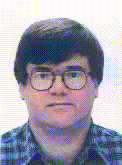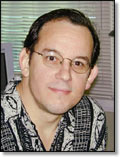|
ROUND TABLE:
Standard/Enterprise Edition EC
RatifiedBy John Bacon
 Nick Briers, Caldera Systems
Caldera Systems is represented by Nick Briers, platform architect for for the
server business line. Caldera has been a leader in the Linux community
adoption of Java. The Java Development Kit is a key component of Caldera's
core distribution for OpenLinux, Open Unix and OpenServer products. And
Briers is no new face to the community. He was the OMG representative for
Amdahl in the UK, and has been in the IT industry for 25 years.
Nick Briers, Caldera Systems
Caldera Systems is represented by Nick Briers, platform architect for for the
server business line. Caldera has been a leader in the Linux community
adoption of Java. The Java Development Kit is a key component of Caldera's
core distribution for OpenLinux, Open Unix and OpenServer products. And
Briers is no new face to the community. He was the OMG representative for
Amdahl in the UK, and has been in the IT industry for 25 years. "The Java
Community Process gives us a voice in the future direction of Java
technologies," Briers said. "This is important to ensure new Java
developments meet our business requirements. Serving another term allows us
to continue developing the relationships necessary to extend our benefit of
the Java platform." Briers says Caldera considers active participation in EC
deliberations and voting a priority. "And we actively participate in several
JSRs (JSR140 and JSR48) as well," he said. As for a peek into the near
future, Briers says Web Services offer customers an excellent technology for
providing distributed business solutions.
 Jason Hunter, Apache Software
Jason Hunter, Apache Software
The Apache Software Foundation is represented by Jason Hunter. He is a senior
technologist with CollabNet, a foundation member and provider of tools and
services for open source-style collaboration. He is the author of the book
"Java Servlet Programming" (O'Reillly) and publisher of http://
www.servlets.com/. He also is a co-creator of the open source JDOM library
for optimized Java technology and XML integration. In short, Hunter knows of
what he speaks. And he speaks of representing the interests of open source
projects and developers who support the Java platform. "The Apache Software
Foundation has spent the last year working to
instill more openness and collaboration in the Java Community Process,"
Hunter says. "We're at a crucial point now where the Executive Committee is
close to
finishing a redefinition of the JSPA legal agreement that members sign when
joining the JCP. With this second term, Apache plans to help complete
that agreement and ensure that it allows for the first time open source
independent implementations of all new JSRs." Hunter says that Apache has
shown by example that open
implementations strengthen the Java Platform and do not mean a loss of
compatibility. Apache hosts several Reference Implementations of JSRs
(including Servlets, JavaServer PagesTM (JSPTM), and the JSTL). Hunter says that the openness of
these
implementations has sped technology adoption and improved compatibility
by allowing vendors to share the same open, reliable base code. "We plan
to work during this second term to change the JCP to allow all
independent implementors of JSRs to release under open licenses," he said.
 Tony de la Lama, Borland Software
Tony de la Lama, Borland Software
Borland, a leading provider of e-business solutions for organizations that
demand a vendor independent, J2EE-based implementation paltform, is
represented by Tony de la Lama, vice president and general manager of
Borland's Java Business Unit. De la Lama is responsible for the strategic and
technical direction as well as the business development, engineering and
marketing efforts of the company's core products based on Java technology.
"We've been pleased to see the cooperation among the companies
that represent
the Java Community Process on the executive committee," de la Lama says. "We
view the JCP as significant to Borland and our customers, who benefit from
contributions that move standards forward. De la Lama says his EC role
continues to involving bringing Borland's industry experience, both from a
technical and a business perspective, to the decision making process while
ensuring the continued support of open standards. De la Lama says it remains
crucial to focus on standards-based technology that helps lower total cost of
ownership and accelerate time-to-market. Thanks to the work of the EC,
customers can now expect that new technologies introduced are not too complex
to use, he says. "Although new technologies are great to have, without the
ability to create new applications using new technologies, their value is
diminished and the costs associated with application development, deployment,
integration and management become higher," he says.
Back to Introduction
|